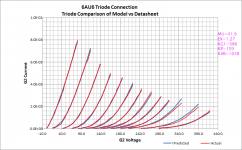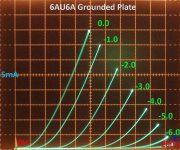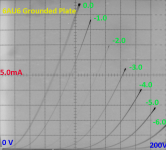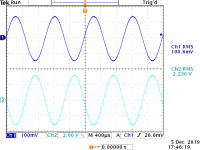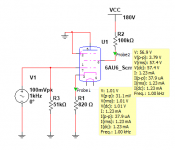For your possible interest:
Have a look at this schematic.
http://frank.pocnet.net/other/AWV_Radiotronics/ckt/AWV_25W_Amplifier_A518_1950_a.pdf
V1 and V2 run the 6AU6 in "low power" triode mode using the screen as an anode with G3 and Anode grounded.
V3 and V4 run the 6AU6 in more "traditional" triode strapped mode with G2, G3 and anode strapped together.
Cheers,
Ian
Have a look at this schematic.
http://frank.pocnet.net/other/AWV_Radiotronics/ckt/AWV_25W_Amplifier_A518_1950_a.pdf
V1 and V2 run the 6AU6 in "low power" triode mode using the screen as an anode with G3 and Anode grounded.
V3 and V4 run the 6AU6 in more "traditional" triode strapped mode with G2, G3 and anode strapped together.
Cheers,
Ian
That pin configuration for the input stages gave the best screening between heater pins and grid pin and anode pin.
http://www.retrovox.com.au/6AU6pAWV.pdf
I also liked the way the schematic showed local star grounding for those input stages - published article in Radiatronics 143. The amp used the prototype Williamson OT made by local Ferguson's manufacturer.
http://www.retrovox.com.au/6AU6pAWV.pdf
I also liked the way the schematic showed local star grounding for those input stages - published article in Radiatronics 143. The amp used the prototype Williamson OT made by local Ferguson's manufacturer.
Last edited:
perhaps a similar idea
perhaps a similar idea from the 6V6 linestage thread.
http://www.diyaudio.com/forums/tubes-valves/102352-6v6-line-preamp-4.html#post1263939
http://www.diyaudio.com/forums/tubes-valves/102352-6v6-line-preamp-14.html#post1773726
tim
perhaps a similar idea from the 6V6 linestage thread.
http://www.diyaudio.com/forums/tubes-valves/102352-6v6-line-preamp-4.html#post1263939
http://www.diyaudio.com/forums/tubes-valves/102352-6v6-line-preamp-14.html#post1773726
tim
Yuppers: I've seen that before, and have a complete set of triode plate characteristics for 6AU6 pents. The really good thing about this is that the u-factor of the 6AU6 pseudotriode falls nicely between that of the 6SN7 and the 12AX7, useful when the former can't provide enough gain and the latter develops too much. It's also much more linear than the 12AV7, with a similar u-factor.
Using the screen as the "plate" of a triode while the plate serves as an electrostatic shield is also a neat trick for electronically noisy environments. Since the screen isn't surrounded by a hot anode, you could probably bust the 2D rating without ill consequences.
Very convenient when you need a singleton triode, and want to use a mini VT, as there aren't many of these out there. There are more Octal singleton, small signal triodes, as most of the mini's are nine pin dual triodes.
Using the screen as the "plate" of a triode while the plate serves as an electrostatic shield is also a neat trick for electronically noisy environments. Since the screen isn't surrounded by a hot anode, you could probably bust the 2D rating without ill consequences.
Very convenient when you need a singleton triode, and want to use a mini VT, as there aren't many of these out there. There are more Octal singleton, small signal triodes, as most of the mini's are nine pin dual triodes.
Here is a set of curves for the 4P1L
http://www.bartola.co.uk/valves/2014/08/04/4p1l-with-screen-as-anode/
http://www.bartola.co.uk/valves/2014/08/04/4p1l-with-screen-as-anode/
Maybe the 'quietness' relates to a typical practical setup, where leakage from wiring layouts may be the measurable relevant difference.
we will see -- I can compare with 417a, D3a in triode mode but have to re-rig the ultra-quiet 180V supply (20 9V alkaline cells in series!)
D3a is current hungry and getting to be quite an expensive tube.
- Status
- This old topic is closed. If you want to reopen this topic, contact a moderator using the "Report Post" button.
- Home
- Amplifiers
- Tubes / Valves
- 6AU6 Triode Mode
